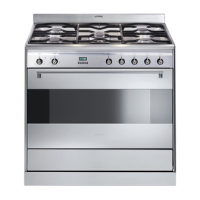
Do you have a question about the Smeg SA9065LPG and is the answer not in the manual?
| Brand | Smeg |
|---|---|
| Model | SA9065LPG |
| Category | Kitchen Appliances |
| Language | English |
Connects the appliance to the power supply, detailing voltage and wire section requirements for safe installation.
Ensures adequate airflow for gas combustion, specifying required ventilation openings and cross-sections.
Specifies minimum safe distances between the cooker and surrounding combustible surfaces and objects for safety.
Procedure for replacing hob burner nozzles to adapt the appliance for different gas types, ensuring correct combustion.
Table detailing burner specifications, gas consumption, and injector sizes for LPG and Natural Gas.
Adjusts the minimum flame level for natural gas hob burners to ensure a stable and regular flame.
Diagrams illustrating the layout and identification of the different hob burners on the appliance for easy reference.
Step-by-step guide for attaching the rear top skirtboard, involving screws, nuts, and alignment of components.
Details on securely fixing the cooker to the wall using a chain and appropriate wall fixings for stability.
Explains symbols, hob burner controls, and electric oven thermostat/function knobs on the appliance's front panel.
Covers the electronic programmer's capabilities, including clock setting, cooking timers, and alarms.
Guide to setting the clock on the electronic programmer, essential after initial setup or power interruptions.
Utilizes the automatic oven switch-off feature at the end of a set cooking time.
Enables automatic start and stop of oven cooking procedures based on programmed times.
Describes the oven's automatic shutdown and audible alarm signal upon completion of cooking.
Details how to adjust the volume of the acoustic alarm on the electronic programmer to three different levels.
Explains how to manually deactivate the acoustic alarm, either automatically or by pressing specific keys.
Explains how to use the electronic programmer as a simple minute counter for timing tasks.
Procedure for cancelling programmed cooking data by resetting the timer to 0:00.
Allows modification of entered cooking data at any time by using the function and variation keys.
Instructions for using the digital timer for setting cooking times and acoustic alerts on specific models.
Guide to setting the current time on the digital timer display, especially after power outages.
How to set the timer for a countdown, which begins after releasing the '+' key.
Procedure for manually stopping the acoustic alarm from sounding by pressing the '+' key.
Explains how to adjust the acoustic alarm volume to one of three available settings.
Allows modification of the timer data set at any moment by pressing the '-' or '+' keys.
Instructions for setting and using the mechanical analogue timer and clock for cooking and timekeeping.
Step-by-step guide for safely lighting hob burners, including checks and thermocouple operation for ignition.
Advice on efficient burner use, selecting appropriate containers, and safety precautions for hob cooking.
Provides recommended minimum and maximum container diameters for various hob burners for optimal use.
Key safety warnings and general advice for initial oven use, including heating, door operation, and steam prevention.
Instructions for using static and fan grill functions, detailing temperature settings and cooking duration limits.
Details the location and proper use of the storage compartment beneath the oven for holding metal accessories.
Guidance on traditional cooking, suitable for single-level use, including pre-heating and temperature settings.
Explains the hot-air cooking system, ideal for multiple levels, ensuring uniform heat distribution without pre-heating.
Instructions for grill cooking, advising on guide placement for different cooking durations and quantities.
Uses hot-air grilling for uniform heat distribution and greater heat penetration, browning food evenly.
Ideal for pastries and cakes with wet covering, providing results in the lower oven area.
Utilizes the fan for quick defrosting at room temperature, preserving food taste and appearance.
Instructions for using the rotisserie spit, covering frame placement and rod insertion for uniform cooking.
Provides cooking times and temperatures for various foods using traditional, grilling, and hot-air methods.
Guidelines for daily cleaning and stain removal on stainless steel and enamelled appliance surfaces.
Instructions for cleaning hob grids and burner caps/flame spreader crowns using non-abrasive detergent.
How to check and clean spark plugs and thermocouples, essential for proper burner ignition and function.
Method for cleaning hob burners by soaking them in hot water with detergent.
Procedure for cleaning the oven interior, including removing parts and cleaning the oven grill.
Tips for cleaning the oven door glass effectively using absorbent paper or a damp sponge.
Procedure for lubricating gas taps if they become blocked or hard to turn, requiring authorized personnel.
Instructions for safely replacing the oven light bulb, specifying the use of T 300°C bulbs.
Step-by-step guide on how to safely remove and refit the oven doors for cleaning or access.
Information on dismantling oven door gaskets for thorough cleaning, performed after door removal.
Periodic checks for burners, gas connections, pipes, valves, and gaskets to prevent operational malfunctions.
